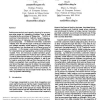Free Online Productivity Tools
i2Speak
i2Symbol
i2OCR
iTex2Img
iWeb2Print
iWeb2Shot
i2Type
iPdf2Split
iPdf2Merge
i2Bopomofo
i2Arabic
i2Style
i2Image
i2PDF
iLatex2Rtf
Sci2ools
SIGECOM
1999
ACM
1999
ACM
A methodology for workload characterization of E-commerce sites
Performance analysis and capacity planning for e-commerce sites poses an interesting problem: how to best characterize the workload of these sites. Tradition al workload characterization methods, based onhits/set, page views/set, or visits/set, are not appropriate for e-commerce sites. In these environments, customers interact with the site through a series of consecutive and related requests, called sessions. Different navigational patterns can be observed for different groups of customers. In this paper, we propose a methodology for characterizing and generating e-commerce workload models. First, we introduce a state transition graph called Customer Behavior Model Graph (CBMG), that is used to describe the behavior of groups of customers who exhibit similar navigational patterns. A set of useful metrics, analytically derived from the analysis of the CBMG, is presented. Next, we define a workload model and show the steps required to obtain its parameters. We then propose a clustering...
| Added | 03 Aug 2010 |
| Updated | 03 Aug 2010 |
| Type | Conference |
| Year | 1999 |
| Where | SIGECOM |
| Authors | Daniel A. Menascé, Virgilio Almeida, Rodrigo C. Fonseca, Marco A. Mendes |
Comments (0)

